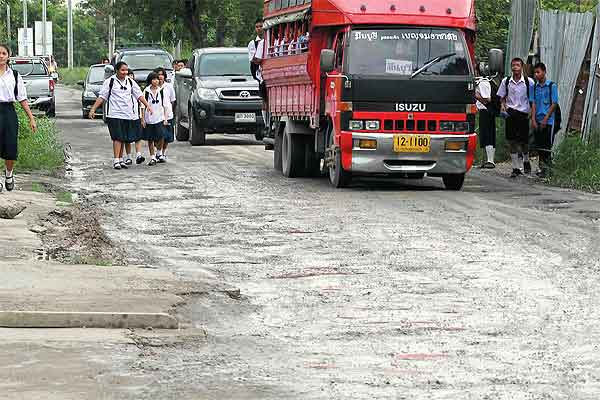Record floods continue torrent of destruction in Thailand – Flooding reaches deeper into Bangkok, residents complain government sacrificing poorer areas
By Ann M. Simmons in Los Angeles
4 November 2011 Floodwaters in Thailand have crept closer to central Bangkok, forcing new evacuations and the closure of one of the country’s largest shopping malls as the deluge threatened to swamp the Thai capital’s subway system, according to international news agencies. Bloomberg news service reported Friday that Thai officials had built more barriers around Bangkok, including a wall of sandbags along a canal north of the city, and dikes were being further reinforced. Officials from Bangkok’s subway system were closely monitoring three stations in the area, but so far all of them remained open, the Associated Press reported. The agency said local media reports put the water’s depth at 15 inches. The monsoonal floods, which began in late July, have killed more than 400 people, and thousands of residents have been ordered to evacuate. More than a quarter of Bangkok’s 50 districts had been ordered evacuated, and nationwide the homes of some 10 million residents had been flooded. The disaster worsened last month when about 40% more rainfall than the annual average filled dams north of Bangkok to capacity, Bloomberg noted. This spurred Thai authorities to release billions of gallons of water down a river basin the size of Florida, spreading the deluge over 64 of Thailand’s 77 province. Citing Thai government data, the news service reported that floodwaters had damaged some World Heritage-listed temples, shuttered some 10,000 factories, and destroyed 15% of the nation’s rice crop.
Flooding continues torrent of destruction in Thailand
BANGKOK (AP) – Thailand’s record floods encroached deeper into the capital Friday, swamping a major intersection in the northern edge of the city center and threatening the subway system. The water from the country’s worst flooding in more than half a century was filling Bangkok’s Lad Phrao intersection, where three major roads meet. Office towers, condominiums and a popular shopping mall are in the area, where local media say the water is 15 inches deep. The intersection is just down the street from the famed Chatuchak Weekend Market, a key tourist attraction. Three stations in Bangkok’s subway system are being closely monitored but are still open. Steel barriers have been put around the underground stations in recent weeks to protect against possible inundation. The flooding, which started in the country’s north in late July and has killed almost 450 people nationwide, has been spreading across Bangkok’s north and west for more than a week. The government has asked residents in eight of the city’s 50 districts to evacuate. Residents in several other districts have been warned that they should be ready to leave. The water has yet to reach the city’s central business district.
Thailand’s record floods reach deeper into Bangkok 
By Michael Sullivan, NPR
4 November 2011 Flooding that has killed more than 400 people in Thailand continues to make its way south into the capital, Bangkok. Tempers are flaring as some residents complain the government is sacrificing poorer areas to the waters to protect more affluent and industrial areas closer to the city center. Heavy monsoon rains that began two months ago in Thailand have killed more than 400 people and show no sign of abating as the floodwaters make their way south into the crowded capital, Bangkok. Anxious residents have stripped store shelves bare of water, rice, and other essentials as they wait. And tempers are flaring as some poorer residents complain that their homes and businesses are being sacrificed to protect more affluent and industrial areas closer to the city center. Bangkok — which means the “city of angels” in Thai — dodged a bullet last weekend when the Chao Phraya river crested at a record high but did not burst its banks and flood downtown as feared. The capital’s business and commercial heart remains dry. Yet some residents of outlying districts say that’s because the authorities directed the water toward their areas, putting them underwater. One neighborhood in Bangkok’s Sam Wa district is on the wrong side of the floodgates, literally. The water there rises up to the windows of the homes that line the canal, while dogs and their owners are squeezed together on stacks of sandbags or makeshift rafts. Shopkeeper Saoem, who gives only one name, helps her sister wash dishes in front of her flooded home. She says houses in the area have been waist deep in water for weeks. A few days ago, angry residents decided to do something about it. They punched a hole in the nearby floodgate, hoping it would drain the water away from their homes and toward the city center. She knows it was wrong, she says, but people were just fed up. The government always takes care of the rich people, but there are lots of factories on the other side of the floodgate that employ ordinary Thais, too, she says. If those factories flood, she says, then those people won’t be able to work, so the government should keep that from happening. “I just wish they’d do something to help us get rid of the water here,” she says.
In Bangkok, residents’ anger rises with floodwaters
